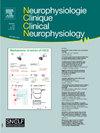立体脑电图(SEEG)在东南亚和大洋洲的发展:对整个区域公平的挑战。
IF 2.4
4区 医学
Q2 CLINICAL NEUROLOGY
Neurophysiologie Clinique/Clinical Neurophysiology
Pub Date : 2025-01-01
DOI:10.1016/j.neucli.2024.103033
引用次数: 0
摘要
背景:有创/颅内脑电图是许多耐药癫痫(Drug-Resistant epilepsy, DRE)患者癫痫手术评估的重要组成部分。颅内脑电图在东南亚和大洋洲的应用很少。本研究旨在记录立体脑电图(SEEG)在整个地区的发展,并强调区域使用和获取的障碍。方法:采用多中心共识进行调查。该调查捕获了机构特征、地理分布、颅内脑电图利用率和SEEG障碍。受访者是该地区具有代表性的癫痫中心。结果:四家已建立颅内/ SEEG的癫痫中心和两家来自未获得SEEG的国家的癫痫中心参与了研究。回答表明:1。在整个区域,获得SEEG仍然受到高度限制,估计每1亿人中只有一个有能力的癫痫中心;2. 该地区有超过5亿人生活在无法获得SEEG的国家;3. 人员配置/财政限制是限制服务增长或新服务发展的普遍因素;4. 由于这些挑战,SEEG的数量已经趋于稳定。结论:该研究以实际数字反映了该地区在获取SEEG方面面临的挑战。SEEG仍未得到充分利用,今后的办法应侧重于区域培训和转诊途径。本文章由计算机程序翻译,如有差异,请以英文原文为准。
The development of Stereo-Electroencephalography (SEEG) in Southeast Asia and Oceania: Challenges to equity across the region.
Background
Invasive/ intracranial EEG forms an important component of assessment for epilepsy surgery in many patients with Drug-Resistant Epilepsy (DRE). Intracranial EEG has been poorly utilized though Southeast Asia (SEA) and Oceania. This study aimed to document the development of stereo-EEG (SEEG) across the region and highlight regional barriers to utilization and access.
Methods
A survey was developed by multicenter consensus. The survey captured institutional characteristics, geographic distributions, intracranial EEG utilization, and barriers to SEEG. Respondents were representative epilepsy centers across the region.
Results
Four epilepsy centers with established intracranial/ SEEG and two centers from a country without any access to SEEG participated. The responses identified that 1. Access to SEEG remained highly restricted across the region with an estimated one capable epilepsy center per 100 million people; 2. The region includes over half a billion people living in countries with no access to SEEG; 3. Staffing/ financial constraints were universal factors that limited growth of services or development of new services; 4. SEEG numbers have plateaued as a result of these challenges.
Conclusion
The study puts into real numbers the challenges faced by the region in accessing SEEG. SEEG remains highly underutilized and future approaches should focus on regional training and referral pathways.
求助全文
通过发布文献求助,成功后即可免费获取论文全文。
去求助
来源期刊
CiteScore
5.20
自引率
3.30%
发文量
55
审稿时长
60 days
期刊介绍:
Neurophysiologie Clinique / Clinical Neurophysiology (NCCN) is the official organ of the French Society of Clinical Neurophysiology (SNCLF). This journal is published 6 times a year, and is aimed at an international readership, with articles written in English. These can take the form of original research papers, comprehensive review articles, viewpoints, short communications, technical notes, editorials or letters to the Editor. The theme is the neurophysiological investigation of central or peripheral nervous system or muscle in healthy humans or patients. The journal focuses on key areas of clinical neurophysiology: electro- or magneto-encephalography, evoked potentials of all modalities, electroneuromyography, sleep, pain, posture, balance, motor control, autonomic nervous system, cognition, invasive and non-invasive neuromodulation, signal processing, bio-engineering, functional imaging.

 求助内容:
求助内容: 应助结果提醒方式:
应助结果提醒方式:


